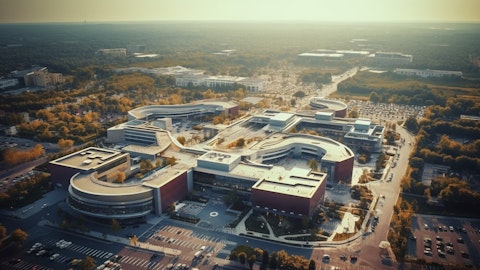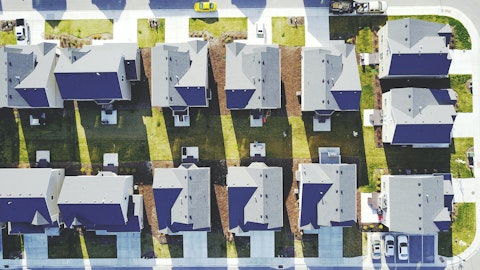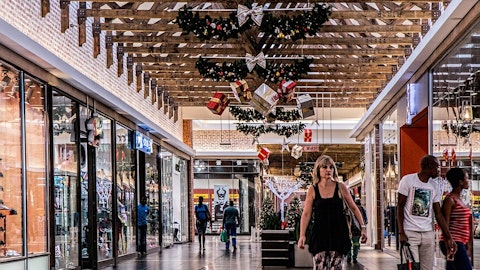David Jamieson: Yes. I mean as I mentioned, quarter-over-quarter, spreads are really indicative of just the population of that given quarter and what qualifies as a comp spreads, so it can be volatile at times. But when you look at the overall ABR growth, we continue to see us moving upwards in that trajectory from quarter-over-quarter where it was year-over-year. So we’re encouraged, obviously, by that direction, I think we’re at $20.32 at this point. And in terms of the TI allocation, we look at the all-in cost, so landlord and TIs collectively. The distribution between those 2 categories is dependent on the type of deal structure you cut. So when you combine those and you look at the trailing 4, we’re right in line there.
And there were a couple of deals this quarter that were more as-is structure, so higher TI allowances were given to those tenants. If you strip those out, you’re around $26 versus that $33 that we posted. So you’re pretty much in line, slightly better than what we’ve seen in the past. And as we look forward into ’24, we do have 29 anchor boxes, I think, that are naked with no options. They do have the highest rent per square foot at $18. We’ve executed 6 of those in the last quarter and those were as-is rents above that and we still had a high double-digit mark-to-market adjustment on that. So you’re seeing room for opportunity to grow in the coming year as well.
Operator: The next question comes from Samir Khanal with Evercore.
Samir Khanal: I guess, Conor, you had a very strong 4Q operationally. And clearly, occupancy continues to move up, both on the anchor and shop side. I guess what’s the potential upside from RPT as we think about maybe the shop space or even occupancy pickup in ’24?
Conor Flynn: Yes, happy to take that. Thanks, Samir. So the small shop, I think, is the real upside there on the RPT portfolio. They’re about 30 basis points below the Kimco portfolio. And when you look at the momentum we’re experiencing in the small shop side, we’re very confident that we should bring that up to the Kimco portfolio relatively quickly over the next 1 to 2 years. We’ve done the same with the Weingarten portfolio and we feel very confident in the team that we have on the ground and the leasing the momentum that we’re continuing to experience today. RPT has a number of upside opportunities. We’re obviously digging in right now and getting very excited. Mary Brickwell Village is one that I mentioned earlier in the call.
The mark-to-market spread there is significant on deals that roll to market as well as some leasing upside and some potential future redevelopment density plays. But it’s not just that site; we have a number of assets in Florida and Boston and other great trade areas that have significant leasing momentum that we think we can execute on. And if the dispositions come across the tape at the time, we think we’re going to be able to showcase RPT dispositions with — once you take those out of the combined portfolio, both the Kimco grocery percentage increases as well as the Kimco’s mixed-use percentage increases. So two strategic accomplishments very early on, hopefully, this year. So we’re excited, obviously, about that opportunity.
David Jamieson: I’d also just add that their lease economic spread is currently 570 basis points relative to their portfolio which is about $12 million of annualized base rent. So we’ll get the benefit of some of that coming online this year as well to complement what we currently have in our SNO pipeline. And then the ABR per square foot relative to ours is a little bit lower. So I think there’s room to run there and benefits to be had. And based on their the spreads that they posted in their Q4 filings, we’re encouraged by the direction of the real estate.
Operator: The next question comes from R.J. Milligan with Raymond James.
R.J. Milligan: Two-part question here on CapEx and I’ll try and get it all in. First, for the Bed Bath & Beyond spaces, you resolved 21 leases. Spreads much better, I think, than anyone expected but I’m curious what the average TI package was per foot and how did that shake out relative to expectations? And then second part, more broadly, I think you’re expecting an increase in CapEx spend in 2024 and I’m just curious what’s driving that? Is that Bed Bath & Beyond? And how much of that is RPT?
David Jamieson: Yes, sure. On the Bed Bath, we’ve been pretty consistent around $55, $60 a foot on the backfills dependent on the structure. Most of these have been single-tenant backfills but if you do look at some slip boxes in the future or a different type of operator, it could be lower or slightly higher but it’s been fairly consistent. Yes, on the CapEx load for ’24, obviously, we have one of the largest pipelines in the sector and one of our largest that we’ve had. So it’s primarily driven by deal cost and execution there. It’s our highest return on capital in terms of any investment we can really make. So we see it’s a great use of funds. And RPT will be — with their SNO pipeline, as I just mentioned, at 570 basis points in their lease economic, obviously, there will be a contribution there as well.
Operator: The next question comes from Caitlin Burrows with Goldman Sachs.
Caitlin Burrows: Maybe kind of on the watchlist side, Michaels, Jo-Ann’s and AMC are top 50 tenants of Kimco, each with a credit rating in the CCC range. So I was wondering if you could go through your outlook for the 3 companies? Or if you don’t want to talk about specific names, just broadly, the lower credit quality tenants, kind of how they’re performing in your portfolio and how that factored into the credit loss expectation in guidance?
David Jamieson: Sure. Yes. We can start with Rite Aid. So last year, we had 21 locations. At the end of the year, we ended with 16. We do anticipate another 5 coming back this quarter. The leasing activity and LOIs that we currently have on those locations are very encouraging and we’re seeing mark-to-markets in the double digits. So again, second-generation inventory is really where the opportunity is to push rents today and that’s what retailers see it. And so that’s — to my earlier comments, you’re starting to see retailers flex on their format to try to work themselves into some of these boxes. As it relates to Jo-Ann’s, that has been another topic of the day. We have 21 locations. And currently, they’re looking at just rightsizing their operating business.
They obviously had a great COVID run. Top line revenues were growing fairly significantly and I think they’re seeing a bit of a reset back to pre-COVID and trying to stabilize their business there. So it’s something that we’re closely watching. Limited rollover in ’24. But again, when we stay close with those operators as well. As it relates to the broader pipeline, it really hasn’t expanded all that much. I think the general health of retailers has been fairly significant. We are active in the pre-leasing side of that equation to get out in front of any opportunities to recapture space. And in some cases, we’re really pushing it to upgrade the quality of the tenancy. Because you do have on the other side of the spectrum, high-quality investment-grade tenants that are looking to grab space.
So they’re also becoming more aggressive in that regard. So right now, we feel pretty good.
Operator: The next question comes from Wes Golladay with Baird.
Wes Golladay: I just want to maybe talk about Mary Brickell Village. I know RPT has some big plans there, they’re already starting to do a lot of work there. Are you changing any of those plans?
David Jamieson: Yes, great question. Appreciate it. I know there’s been a lot of focus in the first part of the year on Mary Brickell. We’re just over a month of ownership. So we’ve got deep into the investigation of both short-term and long-term planning. And right now, the real focus is the upgrading of the quality of the tenancy. There is a tremendous upside potential there and some of the existing rents we’re in the 40s and 50s. And prior to close, you’re getting rents in the high 100 or 120-plus range. So you’re seeing a huge mark-to-market adjustment just on the retail side alone. As we look at forward-looking longer-term plans, we’re still in the early stages of the investigation of what we want to do. But if you’ve been down there, you realize it’s the hole in the donut, right at the heart of Brickell with $20 million visitors walking past that site on an annualized basis.
So there is tremendous opportunity long term at that site and we’re very excited about it.
Operator: The next question comes from Paulina Rojas with Green Street.
Paulina Rojas: The lack of new supply is a key driver of the positive background in the sector. And if demand continues strong, rent should continue to rise. My question is how much rents would have to go up for development to start to pencil for you? I’m not sure if you have looked at this from this perspective but I think it would be an interesting way to frame the risk of new supply coming.
Ross Cooper: Yes, I’m happy to take that. I think when you look at the fundamentals of our business and why we’re so bullish, it is because the challenges of penciling on new development are significant. We estimate, based upon what we’ve seen in costs and land values, that to develop a new shopping center today, you’re well north of $400 a square foot. In many cases, $450 to $500 square foot. So when you think about the yields that any developer would reasonably require, your ABRs really need to be $35 to $40 a foot on average to pencil a new development. When you think about the replacement cost of the shopping centers that we own and the rents that we have, in many cases, we could be half of where replacement cost is today. So from that perspective, it’s hard to envision that there’s going to be any meaningful new development in the near term and it makes you very comfortable with the rents that we have in place today and our opportunity to continue to push that.
Operator: The next question comes from Mike Mueller with JPMorgan.
Mike Mueller: What are you expecting for overall redevelopment spend in 2024? And are you close to activating any major projects that could cause that number to accelerate materially in ’25 and ’26?
Glenn Cohen: Michael, the redevelopment spend is somewhere between $100 million and $150 million. It’s pretty similar to where it’s been running really for the last few years and we continue to look for any place we can because that’s — it’s really an area of great return for us. We wind up in high single digits, sometimes low double digits on those redevelopments. But that’s the range right now.
Conor Flynn: Michael, I will add that we’ve been prioritizing the retail redevelopments because clearly, the returns there are much stronger and that’s where we see significant returns and upside in the portfolio. So if we’re going to activate new projects going forward, that is still a priority for us and continue to mine the portfolio for upside.
Operator: The next question comes from Michael Gorman with BTIG.
Michael Gorman: Just wanted to circle back to the growth potential within the RPT portfolio. And I just wanted to clarify, when we think about the 1.5% to 2.5% that’s inclusive of RPT, what is the impact of the portfolio you’re having on that? And how does that break out between kind of legacy Kimco and RPT as we think about 2024?



